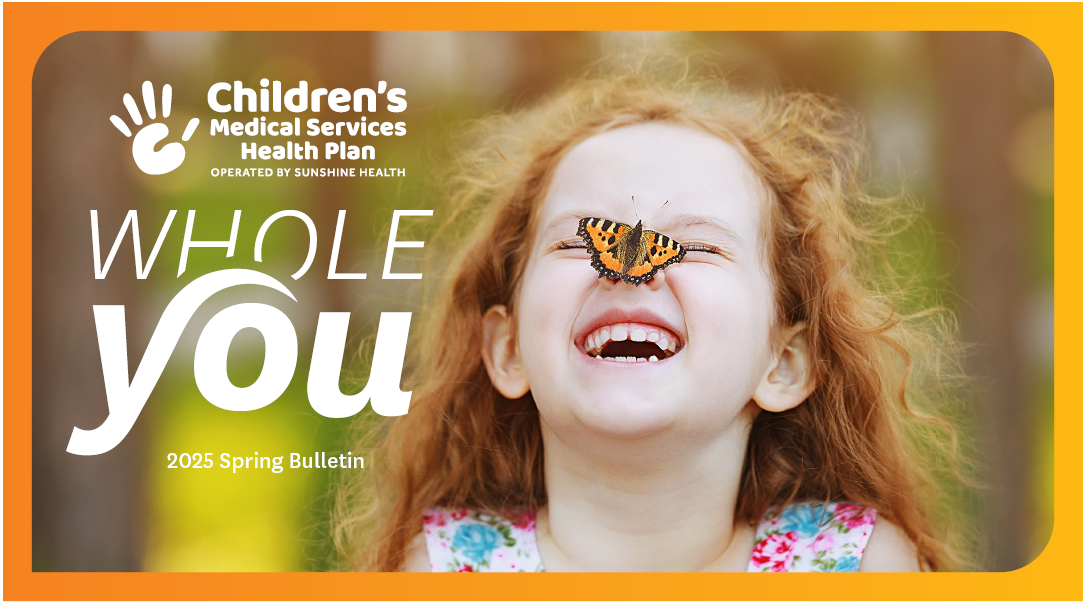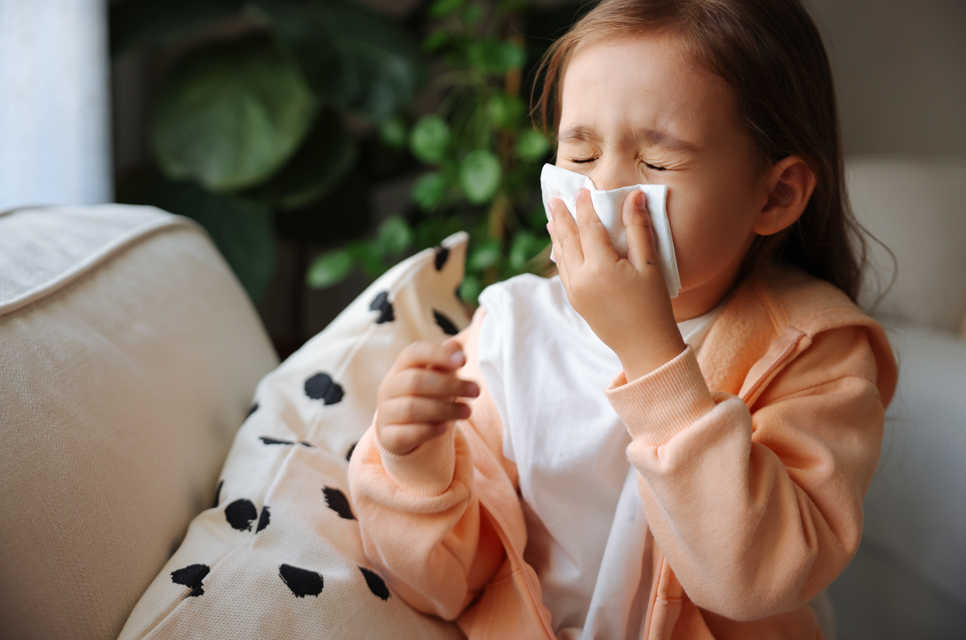Spring 2025

Welcome to another edition of Whole You, a newsletter from CMS Health Plan! Summertime is here, and we want to help you make the most of it for your family.
Learn tips for fighting seasonal allergies and get a list of foods proven to lower stress. Plus, use our Emergency Resource Guide to get ready for hurricane season, which starts June 1.
Read about the importance of taking medication as directed, and how to monitor your child if they are on certain medications, like antipsychotics or stimulants. Brush up on tips for a safe summer, learn about weight loss coaching and more.
We hope you enjoy this issue! Missed a past newsletter? View all newsletters.

Plants are blooming all around at this time of year, pumping pollen into the air. The yellow powder triggers allergies for many, but for kids with asthma, symptoms can be even worse.
Their body will recognize the pollen as a danger and try to attack it. This can cause symptoms in the nose, throat, ears, sinuses and lungs, or even in the stomach lining or on the skin. People with allergic asthma, or asthma caused by allergens, can experience shortness of breath, coughing or wheezing.
If your child has allergies, and especially if they have asthma, it’s important to make sure they stay away from allergens that can trigger an attack. Here are some tips to help them breathe easier this summer.
- Allergy testing. Ask your child’s primary care provider (PCP) about allergy testing. It helps the provider pinpoint your child’s triggers and the severity of their reaction so they can make a care plan to manage your child’s allergies.
- Adjust outdoor time. If it’s dry and windy outside, try to spend more time indoors. Rain helps to wash away pollen, so after a rain storm is a better time to enjoy the outdoors. Also note that pollen counts are highest in the morning and lowest in the evening.
- Check the index. Monitor the allergy index in your area with an app or weather website. Most news stations broadcast allergy forecasts during weather segments. Check each night so you know how pollen will affect your child’s day before they even step outside in the morning.
- Breathe easier inside. Keep windows closed to protect your home from allergy triggers. Always make sure your child bathes before getting into bed to avoid allergen build up on their sheets. Look into high-efficiency air filters for your home and change them often for the cleanest and highest quality airflow.
Use your child's monthly $25 OTC benefit to buy allergy products and other over-the-counter items from CVS Pharmacy. You can order online or by phone and have items shipped to your home or use the store locator to find a location nearby.
Source: American Lung Asssociation

Florida’s Hurricane Season starts June 1 and runs through November. Is your family prepared?
Use our Emergency Guide checklist to build a disaster kit, make a plan and get your family ready. The most important part of your planning is knowing where your family will go during a hurricane to stay safe.
If your child has special medical needs, there are specialized storm shelters throughout Florida that offer more support than general shelters. This could include help with daily tasks or help with medical devices.
If you think your family may need space in one of these shelters, it’s important to pre-register early. This will allow your local emergency management team to prepare for the support your child and family may need. Learn more about Special Needs Shelters.

If you have a child with autism, you already know how their brain may work differently and how unique their perspective can be. They may also be sensitive to certain environments or have trouble transitioning between tasks or places.
Sometimes, you may notice them struggle emotionally, with mood swings or sleep problems. These challenges could be more than just part of autism, signaling overlapping behavioral health concerns, like anxiety, depression or ADHD. All are more common among children on the spectrum.
Children who have autism and a behavioral health diagnosis often need extra support in understanding or managing their stress, emotions and behavior. They may receive treatment through therapy, medication or a combination of the two.
Learn more about how CMS Health Plan supports members with autism, ADHD, anxiety, depression and other conditions with our CMS Diagnosis Guides.
If you think your child is struggling with their emotions or behavior, contact their primary care doctor. You can also reach out to your child’s Care Manager for referrals to mental health providers. Use the Find-A-Provider Tool to search for doctors in your area.

Some conditions require prescription medications that affect the way your child’s brain works. That makes it especially important to follow up with their doctor to make sure their medication is working correctly. Here are two types of conditions to monitor medications closely for:
ADHD (stimulants, antidepressants, etc.)
If your child starts taking ADHD medication, they should be monitored closely for several months until they have a stable medicine routine.
Schedule a follow-up visit within 30 days of starting the prescription. Your child should see the doctor again at least once a month for three to six months. These visits will allow your child’s doctor to ask questions about how the medicine makes your child feel. They can answer any questions you have and make changes to your child’s type of medicine or dosage if needed.
Once your child is stable on their ADHD medication, they can be seen every three months, and eventually every six months. Use the ADHD Guide to learn how CMS Health Plan can support your child. Contact your child’s Care Manager with questions.
Mood/personality disorders (antipsychotics)
Antipsychotics can come with serious side effects that may affect your child’s brain and body. They change the body’s metabolism, or ability to process food.
Make sure your child has a blood test at least once a year to track their cholesterol and triglycerides. Keep an eye out for physical changes, like weight gain, and talk to their doctor about their risk of diabetes.
Weight Loss Coaching: Members ages 10 and up who pledge to lose weight within 30 days and complete six coaching sessions within six months earn $20 in rewards. Ask your child’s Care Manager for details.
Remember: Your child should never stop taking medication abruptly without talking to their doctor. This can cause extreme and dangerous side effects.

It’s not uncommon for Florida to hit record-high temperatures in the summertime. But don’t worry! There are steps you can take to make sure your child stays cool enough and protected from the sun.
Sunscreen: When spending more than a few minutes outdoors, be sure to bring sunscreen with a rating of at least 30 SPF. Your child may need help applying it well – make sure they cover all their exposed skin, including their ears and feet. Sunscreen should be reapplied every two hours and even more if your child is playing in water.
Shade: Choose play areas with shaded options, like trees or covered structures.
Hydration: Small children can’t regulate their body temperature as well as older children and adults. That means they need even more water when it’s hot outside. Be sure your child has access to water and takes plenty of drink breaks when playing outside.
Clothing: Dress your child in cooling fabrics, like lightweight cotton. Long pants and sleeves can protect their skin even more than sunscreen. A hat can protect their face, ears and neck.
Sunglasses: Kids need sunglasses too! Make sure your child has a pair of sunglasses that fit them well to keep their eyes protected from the sun. The best kind block both UVA and UVB rays.
Sources: HeadStart.gov, CDC

Taking medication on time each day exactly as doctors prescribe helps children with chronic conditions avoid pain and complications that can lead to emergency room visits.
For conditions like asthma, diabetes, sickle cell disease, ADHD, epilepsy and more, medications can help children feel and function better. But they only work if they’re taken regularly.
Taking medications differently than the doctor says can cause flare-ups or setbacks for your child. Try your best not to miss doses and never start or stop a medication without a doctor’s approval.
Here are some tips to make sure your child takes their medication correctly:
- Build taking medicine into another daily routine, like brushing teeth or eating lunch
- Keep a checklist or use a pillbox to keep track of doses
- Set reminder alerts on your phone, clock or watch to remember doses
- Coordinate with your child’s school nurse to ensure accurate and timely doses
If your child doesn’t like taking their medicine, it can help to explain to them how their medicine works and how it can make them feel better. If you aren’t sure how to explain or answer their questions, ask their doctor or Care Manager for help.

If your child has been to the hospital for a behavioral health visit, it’s important that they see a doctor within one week of coming back home. This should help your child avoid another admission. Plus, they can earn a $20 reward.
The doctor should be a licensed behavioral health provider, like a therapist or a psychiatrist. They will review your child’s medications, answer your questions and make sure your family has the services you need.
Can’t get to the doctor in time? See a provider virtually with telehealth. You can also search for a provider online or call Member Services at 1-866-955-8770 (TTY 1-800-955-8770). We can help you Monday through Friday, 8 a.m. to 8 p.m. Eastern.

Sometimes life can be stressful. Staying healthy can help you fight the side effects of stress. Did you know certain foods can help? Check out these five foods that may help you reduce some of the tension you’re feeling.
- Add Avocado. Adding B-rich avocados to your diet can help elevate your mood. Avocados contain mono-saturated fat and potassium, which can help lower blood pressure. They have also shown to ward off hunger making you less likely to grab a sugar-filled treat instead. Try it on a tasty turkey sandwich or on top of your salad!
- Bring Blueberries. These tiny berries pack a powerful punch. Their high levels of phytonutrients and antioxidants have been linked to improved thinking. They’re also rich in vitamin C – another natural stress buster. Toss a few in your morning yogurt or pack in your lunch for dessert for that daily boost!
- Nibble on Nuts. Many nuts, like almonds, walnuts and pistachios, may boost your immune system because of their concentration of vitamin E and zinc. Nuts also contain B-vitamins that help your body combat stress. Try spreading almond butter on a piece of whole wheat toast for a morning treat! Or simply package up a serving size of your choice for an afternoon snack.
- Feed on Fatty Fish. A diet rich in omega-3 fatty acids helps keep your cortisol and adrenaline levels from rising when you’re feeling tense or anxious. Fish like salmon, herring and albacore tuna are good choices. Pair a grilled or baked fillet with your favorite green vegetable and you’ll have a stress-fighting, nutritious meal.
- Fill Up on Oatmeal. This complex carbohydrate helps your brain produce serotonin. This feel-good chemical can help you overcome stress. Go with thick-cut instead of instant oatmeal to get soluble fiber that keeps you fuller for longer. Then you’ll be less likely to grab a sugary treat. Make a big batch on the weekends, then heat it up during the week for a quick and easy meal or snack.
Grocery Assistance: CMS Health Plan expanded benefits include $75 per quarter, per household for healthy food items from Walmart. Note: Only members who do not receive SNAP benefits are eligible. Ask your child’s Care Manager for details.
